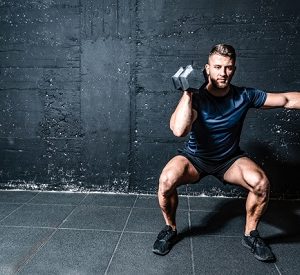5-Tips to Improve Your Functional Fitness Training
Functional fitness training is all the rage these days. It is touted as being the best form of training over traditional exercise. Many trainers and training studios specialize only in this form of conditioning. But, what is functional fitness training exactly? This article will define functional fitness training and give you five key tips to improving it.
Functional Fitness Training is…
Functional fitness training involves performing multi-jointed exercises, such as the squats and lunges, in such a manner that they directly enhance the performance of daily activities, fitness and sport. The primary goal of functional training is to transfer the conditioning improvements, such as muscular strength achieved in one movement, to enhancing the performance of another movement by affecting the entire neuromuscular system. In functional training, it is as critical to train the specific movement as it is to train the muscles involved in the movement. The brain, which controls muscular movement, thinks in terms of whole motions, not individual muscles (like a machine bicep arm curl). One of the most basic functional exercises is the Push-up and one of the most complicated is the Olympic Snatch.
According to the functional training “experts”, functional fitness training uses bands, balls, free-weights, and plyometric exercises in an attempt to condition the body in an un-stable environment.
Functional Exercise:
- Involves the four planes of motion – forward/backward, sideways, rotation, oblique)
- Works the whole body in a coordinated manner (e.g. Squat to overhead Dumbbell press)
- Tends to be multi-joint and multi-muscle (e.g. lunge, push-up)
- Trains movements, not isolated muscles (e.g. kettlebell swing vs. arm curl)
- Progresses from a stable to less stable platform (e.g. two-legs to one-leg)
- Involves bend-and-lift movements (e.g., squatting), single-leg movements (e.g., lunging), pushing movements, pulling movements, and rotational movements
- Incorporates speed and plyometrics (once stability, strength and technique are established)
5-Functional Fitness Training tips and Considerations
- Train simple movements before complex. It is best to start with a simpler version of a functional exercise such as a Snatch by breaking it down into two separate movements such as the squat and overhead press.
- Train for stability before instability. Start by performing push-ups on the floor or a bench before trying them on a balance board.
- Improve Technique before adding load and speed. Ensure that your body and brain are working in coordination with one another by first creating a smooth and effortless movement before adding weight or speed to the exercise. One of the best ways to do this is to perform a 5-second pause at the weakest point of the movement followed by 5-normal repetitions. For example, in a push-up or squat, you hold the repetition in the down position for 5-seconds followed by 5-regular speed (i.e. 1-second up and 1-second down) repetitions
- Fatigue within 20-reps or less than 60-seconds. Initially, technique is critical, so you need to perform the exercise under low resistance for 12-20 repetitions or less than 60-seconds.
- Safety and patience are keys to success. Impatience can lead to injury. Ensure that you have improved your technique and given adequate rest time to allow for your muscles, tendons and ligaments to adjust. Muscles adapt faster (within weeks), than tendons and ligaments, which can take 3-6 months to strengthen. Often, exercisers feel stronger quickly because they can do more repetitions with the same workload, which means the muscles and nervous system have improved. However, tendons and ligaments have less of a blood supply to them than muscles and develop slower. This gives the lifter a false sense of security, thinking she/he can lift more, sooner than the tendons and ligaments can handle. The result is an unnecessary injury.
Happy Training!
André Noël Potvin, MSc, ACE, BCRPA – TFL, is a Clinical Exercise Specialist and Owner of Infofit, North America’s Premier School for Fitness Professionals.



